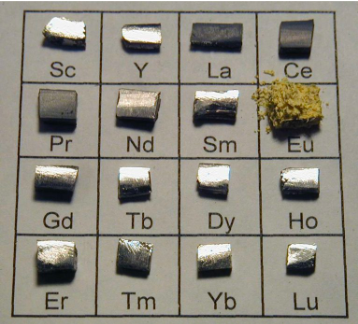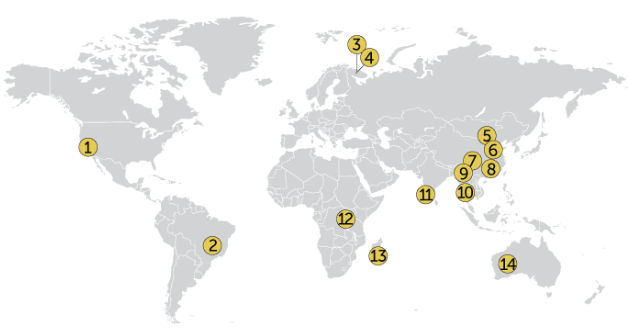Have you ever wondered how our beloved tech gadgets are made possible? Rare earth elements are making smartphones, electric cars, wind turbines, and medical imaging equipment a part of our lives. However, how we obtain these materials can seriously damage the earth if it’s not done responsibly. Rare earth mining is the process of extracting rare earth elements from the earth’s crust. Despite their name, they are not rare on the earth, but they are found in small amounts and extremely difficult to extract, thus causing their relatively low supply. So how exactly does rare earth mining impact the economy and environment of our world?
There’s only one rare earth mining spot in the US, and it was discovered in 1949 by people looking for uranium in the promising mountain range of southern Nevada and southeastern California. This site, later known as the Mountain Pass mine, became the world’s primary supplier of rare earth elements for the next few decades. However, economic competition and environmental pressures soon led to this site temporarily shutting down. The competition mainly came from China, which, in the 2010s, produced 62% of the raw materials and 85% of the global supply of refined rare earths. The demand for rare earth elements around the world increased due to their importance in modern technologies. As a result, the economies of countries possessing these valuable resources can improve significantly.
The process of mining rare earth elements (REEs) makes it harmful to the environment, more so than extracting other types of more common minerals. Mining REEs involves releasing chemicals into the ground to separate the metals and dissolve the elements so they can be refined. Leaching ponds that contain chemicals may leak into natural water sources, resulting in damage to groundwater. The mining of REEs also results in habitat destruction and disruption of ecosystems, which causes displacement and has even led to the of several animal and plant species. Furthermore, it releases tons of toxic waste including waste gas, wastewater, and more importantly, radioactive residue, which can pose environmental and health risks if not handled properly.
Going back to the Mountain Pass mine, the Ivanpah Dry Lake was a wastewater holding pen for the byproducts from processing the rare earth elements. It is connected to the mining site 23 kilometers away through a pipeline. The pipeline ruptured several times over the years: around 60 different spills caused 2,000 metric tons of wastewater containing radioactive thorium to be dumped into the valley. Exposure to thorium can lead to an increased chance of lung, pancreatic and other cancers for visitors and residents. This is just one example of the environmental disasters that can result from rare earth mining.
In conclusion, rare earth elements play a crucial role in modern technologies that we use daily. However, the process of mining these elements can result in devastating consequences if not done responsibly. According to Amy Chu, an assistant professor in chemistry at Mills College, “These are going to be the essential commodities of the energy transition, and any country that really wants to be an economic leader over the coming decades is going to have to find a way to secure a reliable source and supply of these materials.” The economic benefits should not make us neglect the importance of protecting our planet and its inhabitants. With new developments in recycling and the use of alternative materials, we are looking forward to a future where rare earth mining is done in an environmentally-friendly and ethical manner.
Works Cited:
- Cohen, Ariel, and James Grant. “America’s Critical Strategic Vulnerability: Rare Earth Elements – Foreign Policy Research Institute.” Www.fpri.org, www.fpri.org/article/2021/06/americas-critical-strategic-vulnerability-rare-earth-elements/.
- Gramling, Carolyn. Rare Earth Mining May Be Key to Our Renewable Energy Future. But at What Cost? 11 Jan. 2023, www.sciencenews.org/article/rare-earth-mining-renewable-energy-future.
- Linnenkoper, Kirstin. “Is It Now or Never for Rare Earth Recycling? • Recycling International.” Recycling International, 10 May 2019, recyclinginternational.com/non-ferrous-metals/rare-earth-metals/. Accessed 5 Apr. 2023.
- Nayar, Jaya. “Not so ‘Green’ Technology: The Complicated Legacy of Rare Earth Mining.” Harvard International Review, 12 Aug. 2021, hir.harvard.edu/not-so-green-technology-the-complicated-legacy-of-rare-earth-mining/#:~:text=Both%20methods%20produce%20mountains%20of%20toxic%20waste%2C%20with. Accessed 4 Apr. 2023.
- Stone, Andy, et al. “Rare Earth Elements Pose Environmental, Economic Risks for Clean Energy.” Kleinman Center for Energy Policy, 27 July 2021, kleinmanenergy.upenn.edu/podcast/rare-earth-elements-pose-environmental-economic-risks-for-clean-energy/.
This column was submitted by high school student Iris Wang. Student STEM Columns are submitted by high school or advanced middle school students who wish to share their passion for STEM. Students interested in submitting a column should email us at info@areteem.org.
Share this post!
